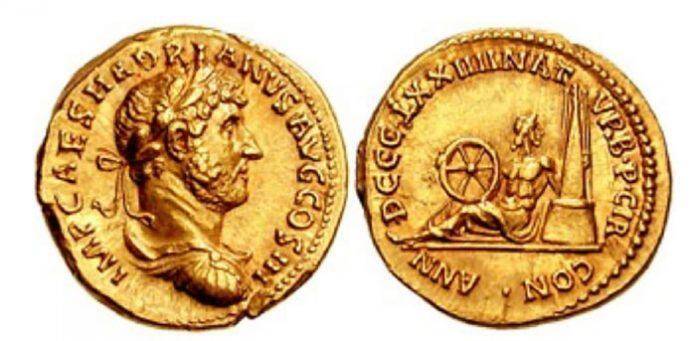1) The Overse
The obverse of nearly every ancient Roman coin has fourdistinct elements:
 1) The portrait of the emperor, one of his relatives or a
1) The portrait of the emperor, one of his relatives or a
previous emperor who is being commemorated.
2) The legend. The wording around the emperor’s head gives not only his name but also honorific titles. The names as well as the titles are often abbreviated and together without separation except where design dictates.
In this example the legend reads: FLIVLCONSTANTIVSNOBC which may be separated
FLIVL CONSTANTIVS NOB C and the complete meaning of which would be Flavivs Ivlivs Constantivs
.* Whe am Nobillissimvs Cacsar. Because old Latin does not have the letter U or J, V and | are used both as vowels and consonants depending on context. His name may therefore
be translated as Flavius Julius Constantius. The final two words mean “Most Noble Caesar”.
3) The head-dress. Head ornaments are usually bare, laureated, diademed. radiate or helmeted. A bare
head often indicates that the portrait is that of a Caesar, that is, of a prince who is below an emperor in rank.
The presence of a laurel wreath denotes an emperor who, nominally at least, is ruling on behalf of his
countrymen and at their will. With the power and influence of the Roman Senate diminishing in the first
century A.D. emperors saw less and less reason to give this token of humility. The laurel started giving way
to the use of the diadem (see picture) which was symbolic of a despot who ruled by the mandate of the army
and, later, by the Grace of God.
The radiate bust has the emperor wearing a spiked crown in alignment with Sol, the pagan Sun god. This
type of bust was popular during the third century but fell out of use upon the rise of Christianity.
Helmeted busts are less common and present the emperor as supreme commander of his armies.
4) The bust type. The earlier Roman coins often depict only the head of the emperor but starting in about
the second century they began to portray the bust as well. These often show drapery symbolic of a
statesman, battle annor to signify his leadership or both as in this example.
2) The Reverse
The reverses of Roman coins depict events and issues of some bearing at the time of striking. These often include religious messages, the commemoration of a successful battle, the deification of a previous emperor, or simply political propaganda.
As with the obverse, nearly all issues have a few elements in common.
 1) The motif. As explained above, these vary greatly with some rulers having literally hundreds of different designs recorded for their reign. It has even been suggested by some historians that coins served as the “newspapers” of their day to spread important messages throughout the empire.
1) The motif. As explained above, these vary greatly with some rulers having literally hundreds of different designs recorded for their reign. It has even been suggested by some historians that coins served as the “newspapers” of their day to spread important messages throughout the empire.
2) The legend. Like is the case with the obverse, the legends are grouped together without separation and its wording is often abbreviated to save space. As can be expected, the legend is a summary of the theme
pictured.
In this example we can tell that the figure is the effigy of the ruler himself holding a labarum and two standards (types of war banners). The wording reads: PRINCIPIIVVENTVTIS; Principi luventutis loosely translating as “To the youthful prince”.
3) The exergue. Usually discernible as lettering bencath a line, and always on the reverse, these codes served
as ancient UPC symbols. They were useful in quality control and the tracking of where the coin was minted.
Mint marks have survived to this day in our pocket change.
in this example we have TS which is the common abbreviation for Thessalonica, a city in modern-day Greece.
The symbol to the right of TS is & which is epsilon, the fifth letter in the Greek alphabet. It means that this
coin came from the fifth internal department, or officina, from the mint located in this city.
